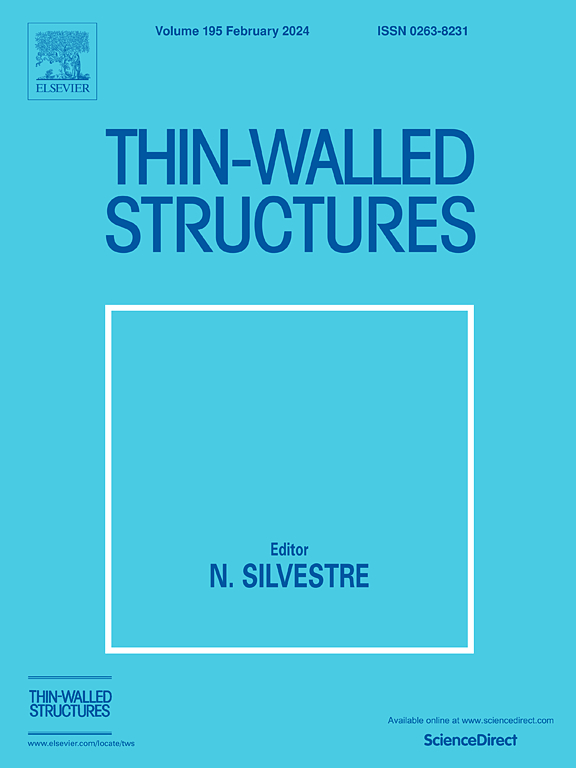通过水冷辅助线弧定向能沉积同时提高高强度 AZ31 镁合金的沉积效率和纳米级沉淀
IF 5.7
1区 工程技术
Q1 ENGINEERING, CIVIL
引用次数: 0
摘要
层间冷却对于调整线弧定向能沉积(WA-DED)镁合金的微观结构和机械性能至关重要。在这项研究中,AZ31 镁合金薄壁部件是在不同的冷却模式下通过线弧定向能沉积(WA-DED)制造的:自然空气冷却(AC)和侧壁水冷却(WC)。系统地比较和分析了不同冷却模式(AC 和 WC 组件)下 AZ31 薄壁组件沉积过程中的温度变化、微观结构和机械性能。结果表明,对于总沉积层数相同的薄壁组件,WC 组件的沉积时间明显缩短,即 WC 模式的沉积效率大大提高。与 AC 组件相比,WC 组件中的等轴晶粒和柱状晶粒尺寸更细,即 AC 和 WC 组件顶部区域的平均晶粒尺寸分别为 ∼106.8 μm 和 ∼74.3 μm。除了在熔池凝固阶段形成的(亚)微尺度次生相颗粒外,由于 WC 组份的熔池在凝固后阶段的冷却速度足够大,因此在 WC 组份中形成了大量纳米尺度的析出物,而 AC 组份几乎不含纳米尺度的析出物。因此,WC 成分表现出优异的拉伸性能,即沿构建方向的屈服强度和极限拉伸强度分别为 ∼170 MPa 和 ∼250 MPa。同时,伸长率达到 9.3%。这项研究为提高镁合金部件的沉积效率和机械性能提供了参考。本文章由计算机程序翻译,如有差异,请以英文原文为准。
Simultaneous enhancement in deposition efficiency and nano-scale precipitation of high-strength AZ31 Mg alloy via water cooling assisted wire-arc directed energy deposition
The inter-layer cooling is crucial for adjusting microstructures and mechanical properties of wire-arc directed energy deposition (WA-DED) Mg alloys. In this study, AZ31 Mg alloy thin-wall components have been fabricated via WA-DED under different cooling modes: natural air cooling (AC) and side wall water cooling (WC) by an innovative WC equipment that provides water cooling on both sides of thin-wall components. The temperature variation during deposition process, microstructures and mechanical properties of AZ31 thin-wall components under different cooling modes (AC and WC components) have been systematically compared and analyzed. It shows that for thin-wall components with the same total deposition layers, the deposition time for the WC component is significantly reduced, i.e., the deposition efficiency of the WC mode has been much improved. Compared with the AC component, the size of both equiaxed and columnar grains in the WC component is finer, i.e., the average grain sizes of top regions in AC and WC components are ∼106.8 μm and ∼74.3 μm, respectively. Apart from (sub)micro-scale secondary phase particles formed during the solidification stage of molten pool, a large number of nano-sized precipitates have formed in the WC component because the cooling rate of molten pool of WC component is large enough in the post-solidification stage, while the AC component contains almost no nano-scale precipitates. Accordingly, the WC component exhibits excellent tensile properties, i.e., the yield strength and ultimate tensile strength along the build direction are ∼170 MPa and ∼250 MPa, respectively. At the same time, the elongation reaches 9.3 %. This study provides references for enhancing the deposition efficiency and improving mechanical properties of Mg alloy components.
求助全文
通过发布文献求助,成功后即可免费获取论文全文。
去求助
来源期刊

Thin-Walled Structures
工程技术-工程:土木
CiteScore
9.60
自引率
20.30%
发文量
801
审稿时长
66 days
期刊介绍:
Thin-walled structures comprises an important and growing proportion of engineering construction with areas of application becoming increasingly diverse, ranging from aircraft, bridges, ships and oil rigs to storage vessels, industrial buildings and warehouses.
Many factors, including cost and weight economy, new materials and processes and the growth of powerful methods of analysis have contributed to this growth, and led to the need for a journal which concentrates specifically on structures in which problems arise due to the thinness of the walls. This field includes cold– formed sections, plate and shell structures, reinforced plastics structures and aluminium structures, and is of importance in many branches of engineering.
The primary criterion for consideration of papers in Thin–Walled Structures is that they must be concerned with thin–walled structures or the basic problems inherent in thin–walled structures. Provided this criterion is satisfied no restriction is placed on the type of construction, material or field of application. Papers on theory, experiment, design, etc., are published and it is expected that many papers will contain aspects of all three.
 求助内容:
求助内容: 应助结果提醒方式:
应助结果提醒方式:


